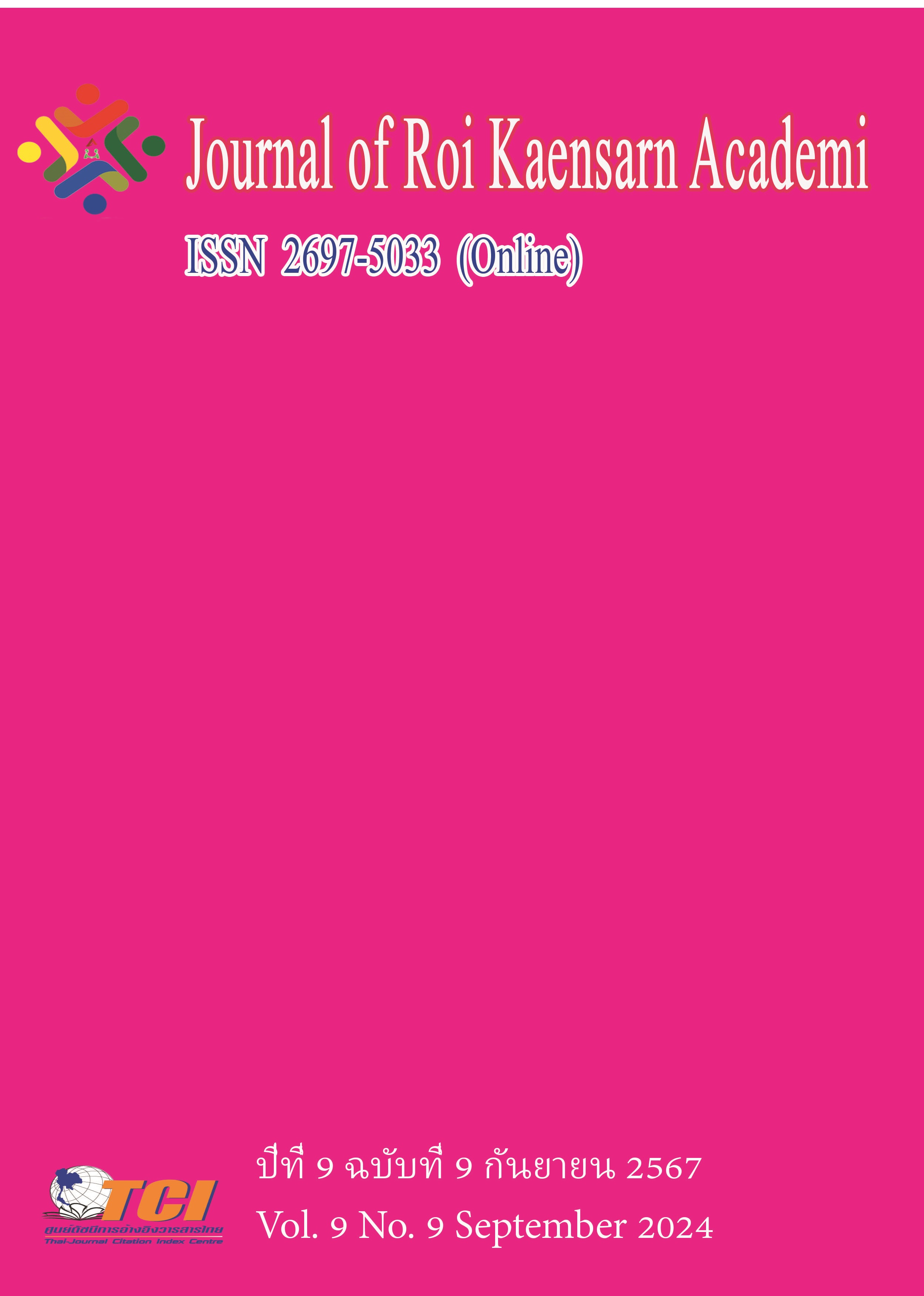รูปแบบการจัดการเรียนรู้แบบมุ่งเน้นทักษะการคิดเชิงนวัตกรรม ด้วยเทคนิค การวิเคราะห์สภาพแวดล้อม : การผสมผสานกระบวนการออกแบบ เชิงวิศวกรรมและการวิจัยเป็นฐาน
Main Article Content
บทคัดย่อ
การวิจัยนี้เป็นงานวิจัยแบบผสานวิธี มีวัตถุประสงค์เพื่อ 1) ศึกษาองค์ประกอบรูปแบบการจัดการเรียนรู้แบบมุ่งเน้นทักษะการคิดเชิงนวัตกรรม จากการผสมผสานกระบวนการออกแบบเชิงวิศวกรรมและการวิจัยเป็นฐาน โดยศึกษาเอกสารและงานวิจัยที่เกี่ยวข้อง และสัมภาษณ์ผู้เชี่ยวชาญ จำนวน 10 คน 2) พัฒนารูปแบบการจัดการเรียนรู้แบบมุ่งเน้นทักษะการคิดเชิงนวัตกรรม จากการผสมผสานกระบวนการออกแบบเชิงวิศวกรรมและการวิจัยเป็นฐาน ด้วยเทคนิคการวิเคราะห์สภาพแวดล้อม นำข้อมูลจากขั้นตอนที่ 1 มาวิเคราะห์สภาพแวดล้อมการเรียนรู้ภายในและภายนอก กลุ่มตัวอย่าง จำนวน 203 คน 3) ประเมินรูปแบบการจัดการเรียนรู้แบบมุ่งเน้นทักษะการคิดเชิงนวัตกรรม จากการผสมผสานกระบวนการออกแบบเชิงวิศวกรรมและการวิจัยเป็นฐาน ผู้เชี่ยวชาญ จำนวน 5 คน เครื่องมือที่ใช้ในการวิจัยประกอบด้วย แบบสัมภาษณ์แบบมีโครงสร้าง แบบสอบถามสภาพแวดล้อมการเรียนรู้ และแบบประเมินความเหมาะสม สถิติที่ใช้ในการวิจัย 1) วิเคราะห์ข้อมูลเชิงปริมาณ ได้แก่ ร้อยละ ค่าเฉลี่ย ส่วนเบี่ยงเบนมาตรฐาน สรุปผลการวิเคราะห์สภาพแวดล้อมภายในและภายนอก 2) วิเคราะห์ข้อมูลเชิงคุณภาพ โดยการวิเคราะห์เนื้อหาและการวิเคราะห์สรุปอุปนัย
ผลการวิจัยพบว่า 1) องค์ประกอบรูปแบบการจัดการเรียนรู้ ฯ พบว่ามี 6 องค์ประกอบ ได้แก่ (1) การวิเคราะห์ปัญหา (2) การศึกษารวบรวมข้อมูล (3) การสร้างต้นแบบนวัตกรรม (4) การประเมินประสิทธิภาพจากการแลกเปลี่ยนแนวคิด (5) การตรวจสอบทบทวนตนเอง (6) การสะท้อนคิด 2) การพัฒนารูปแบบการจัดการเรียนรู้ มีองค์ประกอบและรายละเอียดของรูปแบบเพิ่มเติม ได้แก่ การเตรียมการเรียนรู้และผลสัมฤทธิ์ทางการเรียน 3) ผลการประเมินรูปแบบการจัดการเรียนรู้ ฯ พบว่า การเตรียมการเรียนรู้ การจัดกิจกรรม
การเรียนรู้ ผลสัมฤทธิ์ทางการเรียน และภาพรวมของรูปแบบการจัดการเรียนรู้ ฯ มีความเหมาะสมอยู่ในระดับ
มากที่สุด
Article Details
เอกสารอ้างอิง
กิติมาภรณ์ สมบัติพล และ สุริยา ชาปู่. (2566). การพัฒนาการจัดการเรียนรู้ตามแนวสะเต็มศึกษาด้วย
กระบวนการออกแบบเชิงวิศวกรรมที่ส่งเสริมทักษะอาชีพ เรื่องแรงและสมดุลของแรง ของนักศึกษา
ระดับประกาศนียบัตรวิชาชีพชั้นสูง ชั้นปีที่ 1. วารสารราชพฤกษ์ คณะศึกษาศาสตร์มหาวิทยาลัย
นเรศวร. 1 (21), 42-58.
จิตติรัตน์ แสงเลิศอุทัย, พนม จองเฉลิมชัย และ เทพยพงษ์ เศษคึมบง. (2558). การพัฒนาทักษะการคิดเชิง
วิเคราะห์ของนักศึกษาวิชาชีพครู มหาวิทยาลัยราชภัฏนครปฐม โดยการจัดการเรียนรู้โดยใช้วิจัยเป็นฐาน.
วารสารบัณฑิตศึกษา คณะครุศาสตร์ มหาวิทยาลัยราชภัฏนครปฐม. 59 (12), 1-11.
จักรกฤต ภุชงค์ประเวศ และ พรเทพ จันทราอุกฤษฎ์. (2563). ผลของการจัดการเรียนการสอนโครงงาน
วิทยาศาสตร์ โดยใช้กระบวนการออกแบบเชิงวิศวกรรม ที่มีต่อความสามารถในการแก้ปัญหาเชิง
สร้างสรรค์ของนักเรียนระดับมัธยมศึกษาตอนต้น สังกัดคณะกรรมการอุดมศึกษา. วารสาร
อิเล็กทรอนิกส์ทางการศึกษาจุฬาลงกรณ์มหาวิทยาลัย. 15 (2), 2-11.
ชาญณรงค์ วิเศษสัตย์ และ ประสาท เนืองเฉลิม. (2561). แนวทางการจัดการเรียนรู้ส่งเสริมทักษะการคิดเชิง
นวัตกรรมของนักศึกษาวิชาชีพครู. วารสารบริหารการศึกษาบัวบัณฑิต มหาวิทยาลัยราชภัฏ
อุบลราชธานี. 18 (4), 129-141.
ฐิฏิภัทร์ เดชพิพัฒน์วรกุล, กฤษณา คิดดี และศิริรัตน์ เพ็ชร์แสงศร. (2566). ผลการจัดการเรียนรู้โดยใช้โครงงานสะตีมเป็นฐานด้วยกระบวนการออกแบบเชิงวิศวกรรมที่มีต่อความสามารถในการแก้ปัญหา สำหรับนักเรียนระดับชั้นมัธยมศึกษาปีที่ 2. วารสารศึกษาศาสตร์ มหาวิทยาลัยนเรศวร. 1 (25), 117-130.
พัชรินทร์ เฉลยไกร อัคครัตน์ พูลกระจ่าง และ รินรดี ปาปะใน. (2565). การพัฒนารูปแบบการเรียนรู้โดยใช้การวิจัยเป็นฐานสำหรับจัดการเรียนการสอน. วารสารบัณฑิตศึกษา มหาวิทยาลัยราชภัฏวไลยอลงกรณ์ ในพระบรมราชูปถัมภ์. 3 (16), 161-168.
พระปลัดเขตขันท์ คนงานดี และ ศักดิ์ดา งานหมั่น. (2567). การสร้างสภาพแวดล้อมการเรียนรู้ที่สนับสนุนการ
พัฒนาผู้เรียน. วารสารนวัตกรรมการจัดการศึกษาและการวิจัย, 6 (2), 472-482.
ภานุรุจ กลิ่นโพธิ์. (2562). รายงานการวิเคราะห์การผลิตและพัฒนากำลังคนด้านอาชีวศึกษากับแนวทาง
การพัฒนาประเทศ ภายใต้ยุทธศาสตร์ชาติ 20 ปี. สำนักงานคณะกรรมการการอาชีวศึกษา กระทรวงศึกษาธิการ.
วิชัย วงษ์ใหญ่ และ มารุต พัฒผล. (2562). การจัดการเรียนรู้ที่เสริมสร้างจิตนวัตกรรม. กรุงเทพมหานคร:
ศูนย์ผู้นํานวัตกรรม หลักสูตรและการเรียนรู้ มหาวิทยาลัยศรีนครินทรวิโรฒ.
สุนันท์ สังข์อ่อง. (2555). หลักสูตรและการสอนสำหรับศตวรรษที่ 21. กรุงเทพฯ: มหาวิทยาลัยธุรกิจบัณฑิตย์.
สุพันธ์วดี ไวยรูป และ ภาณุวัฒน์ ศิวะสกุลราช. (2565). ผลของการพัฒนาสมรรถนะการจัดการเรียนรู้โดยใช้
การวิจัยเป็นฐาน ของนักศึกษาสาขาวิชาการศึกษาปฐมวัย คณะครุศาสตร์ มหาวิทยาลัยราชภัฏ
สวนสุนันทา. วารสารนวัตกรรมและการจัดการ. 1 (7), 43-52.
สิวราช อินต๊ะวิชัย และ รัชฎาพร เกตานนท์แนวแห่งธรรม. (2564). การศึกษาสภาพแวดล้อมการเรียนรู้ที่
ส่งเสริมความคิดสร้างสรรค์ของโรงเรียนสังกัดสำนักงานเขตพื้นที่การศึกษามัธยมศึกษาเขต 8 จังหวัด
ราชบุรี. Academic Journal of Phetchaburi Rajabhat University. 11 (3), 34-43.
สำนักงานเลขาธิการสภาการศึกษา. (2559). ปฏิรูปการศึกษาเพื่ออนาคตประเทศไทย มั่นคง มั่งคั่ง ยั่งยืน
นโยบายด้านการศึกษาของนายกรัฐมนตรี (พลเอก ประยุทธ์ จันทรโอชา). กรุงเทพมหานคร: 21 เซ็น จูรี่.
สำนักงานเลขาธิการสภาการศึกษา. (2561). สภาวะการศึกษาไทยปี 2559/2560 แนวทางการปฏิรูปการศึกษา
ไทยเพื่อก้าวสู่ยุค Thailand 4.0. กรุงเทพมหานคร: บริษัท พริกหวานกราฟฟิค จำกัด.
สำนักงานสภาพัฒนาการเศรษฐกิจและสังคมแห่งชาติ สำนักนายกรัฐมนตรี. (2565). แผนพัฒนาเศรษฐกิจและ
สังคมแห่งชาติ ฉบับที่ 13 (พ.ศ. 2566—2570). ราชกิจจานุเบกษา.
เอกนฤน บางท่าไม้. (2561). การพัฒนารูปแบบกิจกรรมการเรียนการสอนโดยใช้ปัญหาเป็นฐานเพื่อส่งเสริม
ความสามารถในการแก้ปัญหาในรายวิชาการถ่ายภาพดิจิทัลสำหรับนักศึกษาระดับ ปริญญาตรีคณะ
ศึกษาศาสตร์มหาวิทยาลัยศิลปากร. Veridian E-Journal Silpakorn University. 11 (1), 30-51.
อดิศร เปลี่ยนดิษฐ์ และคณะ. (2567). รูปแบบการจัดการอาชีวศึกษาหลักสูตรเทคโนโลยีบัณฑิตตามแนวทาง
การบูรณาการการเรียนรู้กับการทำงาน. Journal of Roi Kaensarn Academi. 9 (2), 164-181.
Amelink, C., Fowlin, J., & Scales, G. (2013). Defining and Measuring Innovative Thinking
Among Engineering Undergraduates. American Society for Engineering Education.
th ASEE Annual Conference and Exposition, 120 (1), 1-10.
Australian National Training Authority (ANTA). (2001). Innovation: Ideas That Work for
Trainers of Innovation at Work Skills. Brisbane: Australian National Training Authority.
Bellanca, J. A. and Brandt, R. (2010). 21st century skills: Rethinking how students learn.
United States: Solution Tree Press.
Desai, K. C. (2018). Cultivate the Habit of Innovative Thinking: To Strengthen Your, Professional
Career and Enhance Your Personality. India: Edu creation.
Ekanem, A. (2016). The Power of Positive, Creative and Innovative Thinking. Retrieved from
:https://www.amazon.com/Power-PositiveCreativeInnovativeThinking/dp/154266796.
Evans. (1998). Research Base Learning. New York: McGraw Hill.
Gersten R., Chard D. J., Jayanthi M., Baker S. K., Morphy P., Flojo J. (2009). Mathematics
instruction for students with learning disabilities: A meta-analysis of instructional
components. Review of Educational Research. 79, 1202–1242.
Horth, D. and D. Buchner. (2009). Innovation Leadership: How to use innovation to lead
effectively, work collaboratively and drive results. London: Center for Creative
Leadership.
Kemmis, S & McTaggart, R. (1988). The Action Research Planer (3^rded.). Victoria: Deakin
University.
Lee, C. and Benza, R. (2015). Teaching Innovation Skills: Application of Design Thinking in
a Graduate Marketing Course. Business Education Innovation Journal. 7 (1), 43-50.
McKinsey Global Institute. (2019). Asia’s Future is now. Retrieved from: https://www.mckinsey
mckinsey.com/featured-insights/asia-pacific/asias-future-isnow?cid=other-eml-nslmip- mck#.
Ma, Y. (2014). Innovative Thinking Plays Important Role in Graphic Design. China : International
Conference on Education, Management and Computing Technology.
National Research Council. (2012). Nutrient Requirements of Swine: Eleventh Revised Edition.
Washington, DC: The National Academies Press. https://doi.org/10.17226/13298.
NASA. (2013). Headquarters Oral History Project, Edited Oral History Transcript of A.
Thomas Young. Retrieved from http://www.jsc.nasa.gov/history/oral_histories/NASAHQ
/Administrators. /Young AT/YoungAT_6-10-13.htm.
Strategic Management Insight. (2021). Ovidijus Jurevicius, Mckinsey 7S Model, Retrieved
from: https://strategicmanagementinsight.com/tools/mckinsey-7s-model-framework/.
Weiss, D. S. and Legrand, C. (2011). Innovative Intelligence: The art and practice of leading
sustainable innovation in your organization. New York: John Wiley & Sons.

